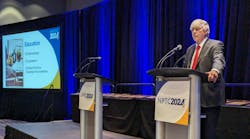Safety in the trucking industry is everyone's responsibility. From the component supplier to the OEM, from the fleet to the owner-operator, everyone plays a critical role in safety. Stemco Inc., as an industry component supplier, is very conscious of the role it plays in safety. Product safety cannot be an afterthought; it must be built into the product from the initial design, considered throughout the manufacturing processes, and accounted for in product installation.
In releasing a product to market, Stemco utilizes a Standard Operating Procedure (SOP), which addresses the safety of a product from several different aspects. In this SOP, product safety is considered from concept to commercialization, including design, manufacturing, and implementation.
An example of Stemco's approach to safety is shown with the Pro-Torq axle nut. A safe product does not occur by accident, it is carefully planned beginning in the design phase. Stemco uses a Failure Mode Effects and Analysis (FMEA) thought process to determine potential failure modes and address those failure modes by design. Axle-nut failure modes can include wear with the bearing face, worn or damaged threads, the nut backing off of the spindle, and inability to be consistently installed to a precise setting.
The Pro-Torq addresses these failure modes by its design. The nut is induction-hardened across the back face to minimize wear with the mating bearing face. With a single-piece nut, the space available for threads increases. This wide thread provides more contact with the spindle threads and can decrease the potential for worn or damaged threads on the nut. A spring-steel locking mechanism provides a positive stop that keeps the nut from backing off of the spindle. Pro-Torq contains adjusting features that allow precise bearing adjustment within approximately 0.001 in. All of these designed features address potential axle-nut failure modes, resulting in a product that is safe and reliable.
Excellent product design is not enough to guarantee safety. The product must be manufactured with consistent, high-quality processes and standards.
Stemco maintains two quality certifications: ISO 9001 and QS-9000. These are recognized worldwide and are renewed on an annual basis to verify that Stemco practices, procedures, and processes meet high quality standards. Stemco also works closely with its suppliers to ensure that these same high quality standards are met.
A product, like the Pro-Torq axle nut, designed to address potential failure modes and manufactured to consistently high quality standards, must still be installed appropriately to realize the goal of safe operation.
Stemco's technical support and field sales force work closely with the trucking industry to provide training on proper use and installation of all their products. Stemco feels strongly about this, evidenced by the Total Quality Maintenance (TQM) certification available to OEMs and fleets, on-site training clinics, published Tech Tips and installation instructions, and field service representative calls. These services are some of the ways Stemco assists product installers in safety.
It is the responsibility of all industry participants to focus on safe products and practices. As a component supplier to the heavy-duty industry, Stemco treats safety very seriously through design, quality manufacturing processes, and product implementation.


